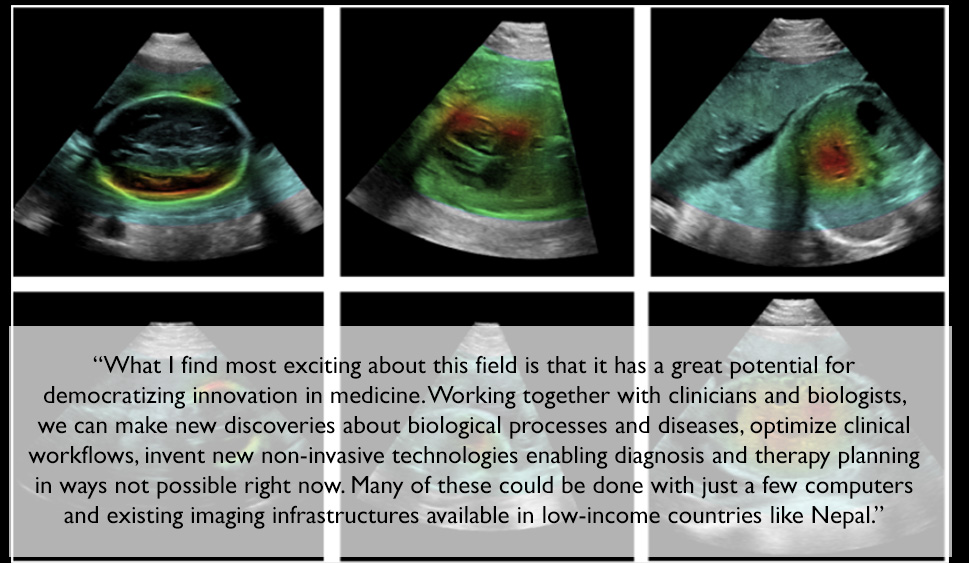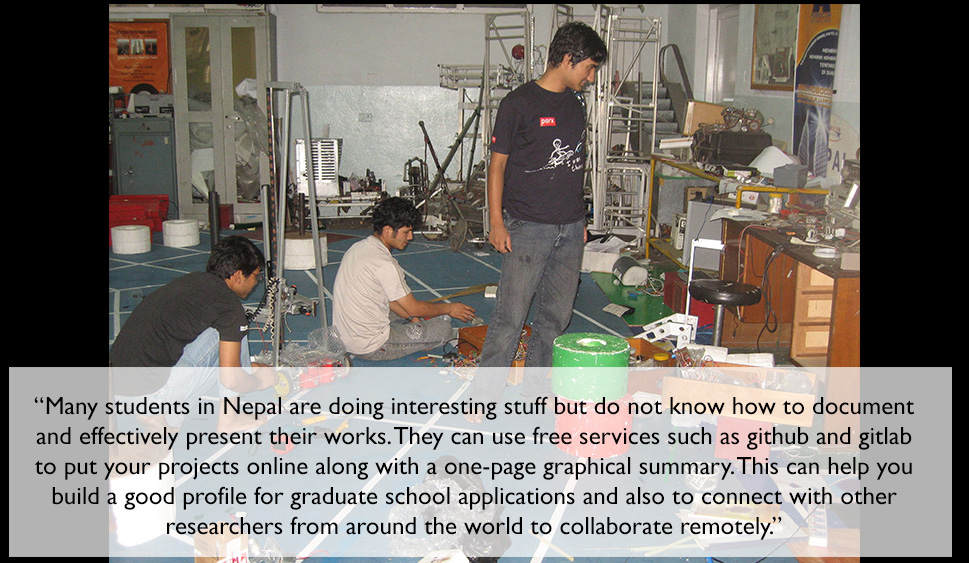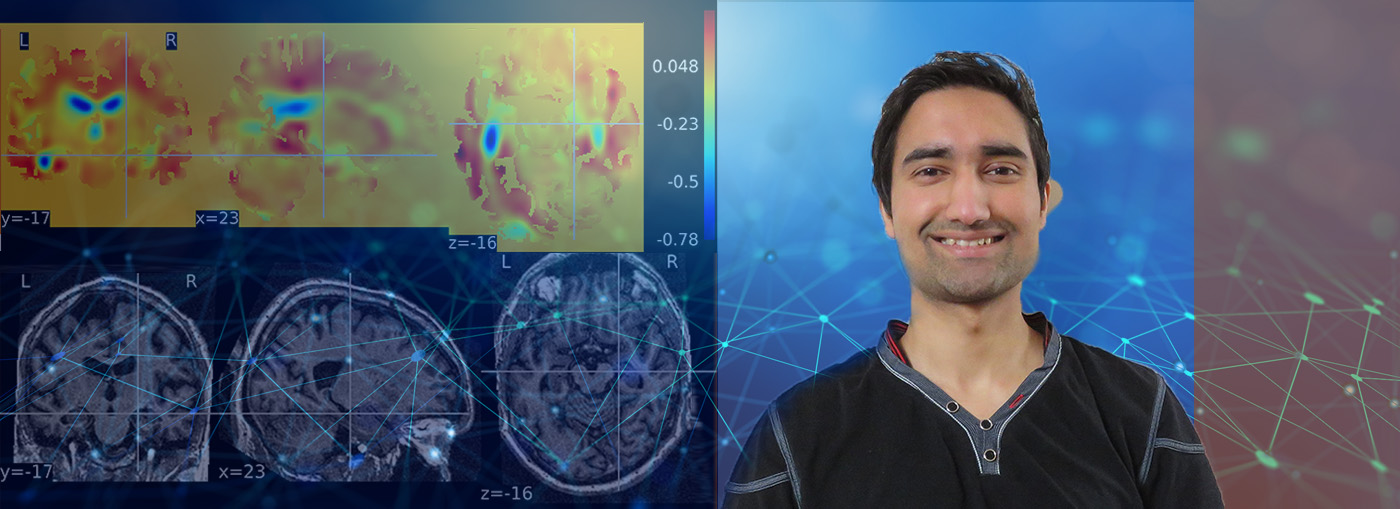He studied Electronics and Telecommunications Engineering from Pulchowk Campus, IOE, Nepal where he was an active member of student-run robotics club for three years. He led and mentored teams representing Nepal in annual international robotics competition involving 15-20 countries from Asia Pacific region. He was also an Erasmus Mundus visiting student at University of York, UK in 2009. Moving to France for his higher studies, he did his 1st year of MSc in Computer Vision at the University of Burgundy and 2nd year in Computational Biology and Biomedicine at the University of Nice Sophia Antipolis. He completed his PhD at INRIA, France.
Bishesh Khanal Website
Please tell us briefly about your current research. What do you find most exciting about it?
My current research revolves around using mathematics, computer vision, image analysis, modeling and machine learning to help develop technologies that allow better diagnosis, prognosis, therapy planning in medicine, and to better understand biological processes. It seems that there is no single consistent term to describe it yet, but I think the terms Medical Imaging Informatics (MII) and Computational Medicine (CM) capture most of my research domain.
iFIND is the main project I am working on right now. It aims to develop better technologies and ways of doing a freehand fetal ultrasound (US). Currently, US diagnosis of many fetal conditions requires a high level of expertise to take the fetal images properly. But there are not enough experts even in the UK, let alone low-income countries such as Nepal. Our project is working on a robotic system that automates the process in an operator-independent way, allowing non-expert sonographers to acquire high-quality images that could then be used retrospectively (even remotely) by experts to make a proper diagnosis. I find it very motivating and am enthusiastic about the possibility that non-experts such as female health volunteers equipped with this kind of technology can help pregnant women living in rural areas.
What I find most exciting about this field is that it has a great potential for democratizing innovation in medicine. Working together with clinicians and biologists, we can make new discoveries about biological processes and diseases, optimize clinical workflows, invent new non-invasive technologies enabling diagnosis and therapy planning in ways not possible right now. Many of these could be done with just a few computers and existing imaging infrastructures available in low-income countries like Nepal.

What are the recent advancements and breakthroughs coming up in the field of Computational Biomedicine?
In this century, we will see much more applications of mathematics, computational sciences and data science to biological problems. The availability of increased computational power and the recent advances in computational sciences make it possible to explore and model multi-scale systems from the level of genes to cells to organs to large population of organisms.
Computational Biomedicine is a very broad field and there are a lot of exciting advancements and breakthroughs coming up. Instead of specifying few of them, let me focus on topics involving MII and mention two very promising directions:
i. Disruptive innovations based on computing technologies that make novel use of existing types of clinical data (e.g. patient history, imaging) to transform clinical workflow and healthcare service.
ii. Imaging genetics to gain insight into complex biological mechanisms by discovering associations of DNA variations with structural and functional phenotype measured from non-invasive imaging data.
How did you get interested in Computational Biomedicine?
I used to spend a lot of time in robotics club of Pulchowk Campus building machines for different robotic competitions. During that time, I developed a passion for providing machines the ability to see just like we do and therefore went to France to study MSc in computer vision. This is where I started getting really amazed with the human brain. It is so easy for us to take for granted our ability to see and interact with the world around us. But if you think about it, our brain is doing absolutely amazing work in processing all the complex signals coming from the eyes and making sense of the surrounding by having learned this over the course of a time.
I wanted to learn more about why brains are so successful in vision tasks. Therefore, after one year of Msc, I moved to the south of France to study MSc in Computational biology and biomedicine for the second year where I could take courses in neuroscience and MII. While the neuroscience course offered there was very theoretical, MII courses helped me see the immense potential of making a big impact in clinical medicine not only in the developed world but also in low-income countries like Nepal.
Tell us about a time you made an exciting breakthrough — or any other highlight in your journey so far.
I don’t think I have made any big breakthroughs yet. But there are certainly some highlights that are worth mentioning.
Looking back, some of the initiatives I took and the works our amazing team at robotics club in Pulchowk Campus did were remarkable.
In our works published this year, we have some important contributions in developing and using deep learning techniques to various problems in fetal US imaging that will help in devising technologies allowing non-expert sonographers to acquire high quality US images.
Researchers have an important responsibility to explain difficult concepts in a simple way and to train next generation of curious minds. I and my colleague Nina Miolane, made a video for an educational challenge in one of the premier conferences of our field, for which we also won the first prize.
Tell us about a time you had serious doubts about your own ability in the fields you chose. How did you overcome that?
I am not sure if it was a serious doubt on my ability to pursue a very theoretical career or a prudent decision after weighing up all the factors that mattered to me including the determination to return to Nepal, but the closest thing I could mention is the choice I made to move to MII rather than to neuroscience during 2nd year of my Msc.
Although not particularly a doubt in my technical field, it is perhaps worth mentioning here that I am not happy with my writing skills at all. There are quite a few drafts I’ve written on various topics of public interest that are dumped somewhere in my computer. They would have been public by now had I been happy with its quality. This is something I haven’t overcome yet; I know that I can improve with a lot of practice and experience, but haven’t managed to make this a priority yet.
If you were in the admissions committee, what qualities would you look into a prospective graduate candidate in your field?
Their academic profile is useful as a baseline but what can make the difference is extra-curricular projects demonstrating their aptitude to initiate ideas on their own or a track record of working hard on the topics of their interests. On the technical side: evidence of their ability to code computational models or algorithms, and their ability to use mathematics in solving real-world problems via example projects.
How can prospective graduate students prepare themselves for being a part of cutting-edge research labs in your field?
No matter what engineering you do, learn how to code properly to develop computational algorithms as it is becoming very important these days. Getting some exposure to deep learning techniques can also be helpful which should not be difficult as it is getting so popular these days and there is a vast amount of online resource available. Unfortunately, the undergraduate teaching of mathematics in engineering schools of Nepal is not great. So, try to utilize the resources available online to do some small projects and take into practice the mathematical concepts taught in the class. Be open about the projects or questions you choose. They can come from many fields such as biology, chemistry, physics, mechanics, finance or social science. You want to learn the skills to apply computational thinking and mathematical expertise to a wide range of problems present in the world. There are so many interesting problems in health, agriculture, energy, climate change, governance etc.
If you really want to work on MII, there are a lot of interesting datasets publicly available here.
Many students in Nepal are doing interesting stuff but do not know how to document and effectively present their works. They can use free services such as github and gitlab to put your projects online along with a one-page graphical summary. This can help you build a good profile for graduate school applications and also to connect with other researchers from around the world to collaborate remotely.
Finally, I have observed that many students in Nepal think of going only to the United States. It is important to broaden the horizon and be aware of brilliant and world-leading institutes and labs in countries such as France, Switzerland, and Germany, to name a few.

Can you recommend 3 resources for people looking to get into your field?
– Computer Vision News magazine provides recent news and papers in the field of computer vision and medical imaging.
– Browsing the website of my previous lab where I did my PhD can provide some idea about the field.
– Machine learning is becoming an important part of our field. There are a lot of resources on machine learning, but starting a Twitter account might be a good idea! I have not (yet) opened my personal account on Twitter, but it seems that a lot of researchers are using it to disseminate latest papers in machine learning and discuss both scientific and social aspects of artificial intelligence.
What are your observations about the research scenario in Nepal? How can we make our education system more conducive to innovation and research?
This is a topic of great interest to me, so apologies if the answer is a bit too long here.
Current research activities in Nepal is poor with only a few exceptions. Academics keen on doing research find it very tough and get discouraged. However, there is a potential to change this. There are many of us in Nepal and abroad either working or waiting for opportunities to contribute to the change. This is a multi-dimensional complex problem needing input from various sectors: education institutions, political leadership, entrepreneurship, government and local communities.
One of the major interventions needed in making education system conducive to innovation and research would be on improving the quality of teachers in primary-secondary education. But, I would like to touch upon the other major intervention needed on which I really want to spend time in the coming years and contribute: transforming the higher education and research.
I believe that there are three main pillars for building a strong foundation of research and innovation: Academia, Research and Industry. Nepal has neither a substantive history of doing rigorous science nor any remarkable contribution to the modern science and technology (S&T) that have shaped up today’s society. Perhaps because of this fact, our society and politicians have not really internalized the importance of S&T. Many of us subconsciously think that S&T gets developed elsewhere and we can only adopt it. We need to make a shift in this mindset. There are so many important problems in Nepal in health, agriculture, energy, climate change, transportation, governance system etc. which could be solved by research and innovation. There are some inspiring people and start-up companies taking initiatives in Nepal, and I have seen that there are many others with very interesting ideas. However, the problem is that there are very few researchers with a good grasp of state-of-the-art technologies who could help potential innovative ideas to be realized as real products and solutions. Particularly in the informatics field, industries are under great pressure to be at the cutting-edge technologies to remain competitive. However, in Nepal, industries cannot really make a massive investment for a full-fledged research department. This is where industry, research and academia should work closely together helping each other grow. Industries can fund various research initiatives, scholars and scientists. Researchers will train and engage students to build the foundations from which industries could reap the benefits by utilizing the new knowledge and trained manpower. It might still be difficult to generate funds for fundamental research; there are many important research topics that can have a great impact on the society but are not necessarily linked with industrial or commercial applications. For this, we will also have to push the policymakers and the government to reform the university system and allocate much more funds to research.
We have formed a team of 12 researchers around the world and Nepal to establish a research institute with a vision to bring all three pillars together under one roof. We are also in discussion with some of the other research institutes to form an alliance for closer collaboration, and for engaging with the government to reform policies that would help create an environment conducive to research and innovation. If anyone is interested in contributing with their expertise, or with investment, we would be happy to discuss it.
I initiated abhinavnepal.com about a year ago where you can find or add Nepali scholars, research institutes working in Nepal or innovative tech companies. We are now a team of two working on rebuilding the website to make it searchable and much easier to add new scholars via a simple web-form.
I have met and interacted with many many amazingly qualified Nepali people very eager to contribute to transforming research and higher education in Nepal. What we really need now is to try to coordinate and find ways to direct all of our scattered efforts into the same direction so that we can actually make big things happen.
Tell us about the role of mentorship in your professional life.
There have been quite a few important and difficult decisions I have had to make during my professional career. Speaking with peers, seniors, professors, and my advisers have helped me make choices and shape up my career.
What is the best career advice you have ever received?
I can’t remember one particular advice right now, but some of the teachers and professors right from my secondary school days to my PhD have had important contributions to where I am now.
The career advice you wished you received in your twenties.
I feel like I am still in my twenties 🙂 Yes, no more in twenties for over a year!
Computational and mathematical skills are so important in solving a wide range of problems in various fields. I wish I knew this during my Isc (late teenage) instead of in the later stages of my undergraduate degree.
Please share your experiences on opportunities and responsibilities of being at the forefront of cutting-edge research as a Nepali national.
I feel really privileged to be working in such a multidisciplinary environment which will be more and more common as the world heads towards the Fourth Industrial Revolution (4IR). We are a part of the large section of the world population who missed out on the first three industrial revolutions. There is an opportunity and a challenge for the world to change this for the upcoming 4IR. Cyberphysical systems and AI-based technologies are changing the ethical values and norms of society and this is bound to continue in the future. Decisions on how we use the technologies can have a profound impact on the planet and to the social values. Some example topics: human-robot relationships, virtual social worlds, longevity and privacy. If the majority of the population are left out from being properly engaged, we might have to face new forms of global conflicts or neocolonialism in the coming decades. As a member of the scientific community responsible for the potential 4IR, it is important for us to be aware of these global contexts and explore how we can contribute positively.
Your final words of advice for someone who wants to get into your field.
Don’t fear to dream big, don’t let the curiosity you have as a child go away. Remember that there is no alternative to hard work and perseverance. Having said all this, don’t forget to enjoy your life and follow your passion!

Leave a Reply